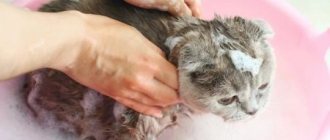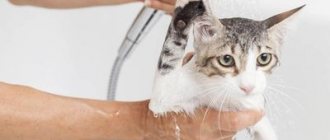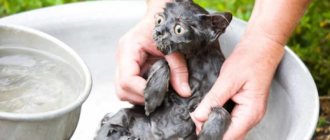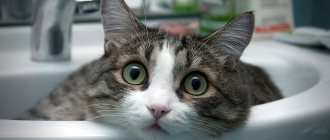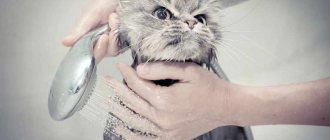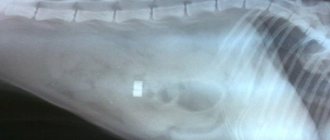Cat breed
: yard.
Asks : Basilisk the Beautiful. The essence of the question : how to bathe a cat if there is no shampoo?
Our cat ran outside in the morning, for the first time in 5 years. The cat is neutered, we were surprised ourselves. Came in the evening of the same day. We wanted to give him a bath yesterday, we don’t know where he was climbing. And we don't even have cat shampoo. And there are no veterinarians nearby either.
Is it possible to bathe a cat with regular shampoo or soap?
Among many cat lovers, there is an opinion that pets should not be bathed, but sometimes there is an urgent need to wash the cat. And these are not only cases when the animal has caught fleas or is very dirty, but also, for example, preparation for an exhibition.
conclusions
For regular use, it is better to purchase a special shampoo for cats.
If you nevertheless decide to bathe your pet and use human shampoo for this, then thoroughly wash the animal’s fur. Otherwise, when licking itself after bathing, the animal may lick off the product that remains on the fur and become seriously poisoned.
Washing with regular shampoo can be practiced only in case of one-time bathing of the pet. If you plan to subject your cat to regular water treatments, it is better to purchase a special cat shampoo.
How to properly wash a cat if he is afraid of water
First you need to prepare the bathroom. If a cat is afraid of water, then everything should be done so that the animal does not suspect anything and does not hide somewhere under the sofa in advance. From the bathroom you should remove bottles, bottles and other objects that could unexpectedly fall. It is better to place a rubber mat on the floor to avoid slipping on water that may splash during the washing process. You should open the shampoo and conditioner in advance and place them so that you can reach them without any problems. You should also bring a couple of thick terry towels to the bathroom. A cat with long hair must be combed in advance, otherwise during the washing process it will be difficult to wash out the shampoo, and the hair may become matted even more. It is better to wash the cat either in the bath itself, placing a small rubber mat on the bottom that will not slip, or in the sink, if its size allows for such a procedure. It is not advisable to use a basin; the animal will cling to its edges, this will create additional difficulties. If the cat is very afraid of water and is quite aggressive, you can put special silicone attachments on the claws. They will not harm the pet’s health and will protect the owners’ hands from deep scratches. It is better to first change into clothes that you won’t mind getting splashed with soapy foam and water. You should fill the bath with water so that it touches the cat’s tummy. Moreover, it should be a temperature in the range from 33 to 40 degrees. The most ideal is the temperature of the human body. You also need to prepare a bowl of water to wash off the soap suds. It is better not to use a faucet, shower or hose; the noise can greatly frighten the cat. When you pick up an animal in your arms, you should not immediately rush to the bathroom with it. It is necessary to stroke and talk to the cat, trying to control its nervous tension. When entering a room, the doors must be closed tightly. So, it will be easier to catch the cat if he can get out of the bath. After carefully lowering the cat into the water, holding it, you should wait a while for the pet to get used to the water. After using gentle movements, moisten the wool with your hand or using a glass. Water is applied to the head and muzzle last.
In this case, you should act carefully so that moisture does not get into your ears, since water can provoke the development of inflammatory processes. To be on the safe side, you can put small balls of cotton wool in your cat's ears. When the animal's skin is sufficiently wetted, a small portion of shampoo is applied, while the cat is held by the front paws
After thoroughly foaming the product, rinse it off thoroughly. The procedure can be repeated up to two times, especially if the wool is very dirty. If possible, after shampoo you should use a special conditioner for animals. When all basic water procedures are completed, the cat is quickly wrapped in the first prepared towel, which will absorb the main moisture. Then, replacing the towel with a dry one, holding the animal tightly, you need to move the cat to the room where it will dry.
To finally understand how to properly wash a cat at home, you can watch the video instructions:
After washing, it is not necessary to dry the animal with a hairdryer. This device, producing a fairly loud sound, can further traumatize the pet’s psyche. Therefore, a hairdryer should be used in exceptional cases or when the cat has been accustomed to it since childhood.
Cat Bathing - The Ultimate Guide
Cats are afraid of water, then how to wash a cat and whether the procedure is necessary. What is needed for bathing and is it possible to wash a cat with regular shampoo. When not to bathe a cat.
Many cat owners shudder when faced with the prospect of bathing their pet. Past bitter experiences or embellished stories from friends often conjure up images of a wet chaos in the apartment, a poor tortured animal climbing on the walls out of fear, or, even worse, on hands with its claws fully extended. As a result, most owners try to completely avoid bathing their beloved pet, hoping that the cat will serve itself, by licking, for example. How to wash a cat if she is afraid of water? We offer a complete guide.
In fact, cats can be easily trained to follow a regular bathing routine. Professional breeders often shower their animals as part of their care. Continuous repetition of the procedure accustoms cats to water in the same way that their larger wild cousins learn to swim in rivers, catch fish and even play in the shallow waters of lakes and streams. A cat is afraid of water - this is a myth, it is simply unpleasant for her.
Cats that are not used to bathing do often panic at first, but you need to remember that most animals will be happy to be in the “heavy rain.” The main idea throughout the bathing process is the peace of mind of the owner. If the owner behaves relaxed and does not make sudden movements, the cat will quickly appreciate all the benefits of water treatments and will soon get used to it. At least it should.
How to wash a cat: types of shampoos for cats
They may differ in release form, as well as in their state of aggregation. Shampoos can be:
- Dry. In the form of free-flowing powders.
- Classic. That is, the same as in humans, which must be applied to wet wool.
- Shampoos in sprays. This is a new type that does not contain moisture, so there is no need to wash your cat before applying shampoo. There's no need to rinse it off either.
Shampoos for cats
Purpose of shampoos:
- According to their action, shampoos can be cosmetic . They are used only if it is necessary to remove dirt from your pet's fur.
- Medicinal. This kind of shampoo is also divided into several types, depending on the problem. There are shampoos for ringworm, fleas, and bacterial infections. Remember that flea shampoo contains an insecticide, so such products cannot be considered completely safe. It is necessary to carefully monitor your pet to ensure that the product does not get into the eyes, ears or mouth. Because this can provoke poisoning of the animal. Anti-lichen shampoos are also often used. They contain antifungal drugs that help fight rashes.
- Antibacterial shampoo most often contains an antiseptic. In the case of a cat, most likely it is Chlorhexidine or Miramistin. The product allows you to get rid of a bacterial infection in a short period of time.
- In addition, there are special shampoos that can tint your pet's coat. That is, you can separately purchase shampoo for white and black cats. They help give a beautiful shade to the coat and also care for it. Please note that toning shampoos cannot be used before visiting the exhibition. Because your cat may be disqualified.
Shampoos for cats
Please note that under no circumstances should human shampoo be applied to the skin of hairless cats. That is, these are sphinxes, as well as Egyptian breeds that have practically no hair. The fact is that their skin is very sensitive to various kinds of substances, and dries out very much when exposed to regular shampoo.
For such cats, special products have been developed that allow you to moisturize the skin and form a protective silicone layer on its surface, which prevents the penetration of microorganisms, as well as flaking of the skin.
Bathing a kitten
Combing and trimming nails
The first thing you need to do is trim your pet's nails. This simple procedure will allow you to remain unscratched while swimming.
Typically, cats do not like to have their claws trimmed, so before starting the manipulations, the owner must pet the pet. First you need to press on the pads on the paws, releasing the claws. You need to trim the claw down to the pink area where the veins and nerves pass. The procedure will be painless if you do everything correctly and remain calm.
If during manipulation you injure the pink area, you need to apply a hemostatic or antibacterial agent (hydrogen peroxide, etc.) to the bleeding wound.
With regular grooming, the animal will be more relaxed about the procedure. Before going to the bathroom, it is recommended to comb the animal’s fur and remove all tangles. This will make it much more comfortable for both the cat and the owner during water procedures.
Where to swim
Another important preparation point is choosing a place to bathe your cat.
Bath
Maximum conditions and ease of washing are in the bathroom, using a shower.
Among the obvious advantages:
- unlimited amount of water used;
- water pressure adjustment;
- temperature selection;
- Mobility of the shower head for thorough cleaning.
However, it is the soul that cats fear most: it creates noise that frightens them. It is preferable to turn the shower head on to the “soft” jet mode.
How to properly cut and shave a cat
Why do cats go bald?
Furminator
Basin
A cat is exposed to less stress when bathing in a basin. The absence of sharp loud sounds and a calm environment predispose her to the procedure.
Bathing a cat in a basin is associated with a number of inconveniences for the owner:
- the need to water the animal with a ladle;
- frequent water changes.
During the washing process, the pet will catch its paws on the edges of the container, which may cause the basin to tip over. This will frighten the animal and lead to additional cleaning.
If your pet is very afraid of water
Veterinarians advise not to rush into water procedures, but to give the baby time to adapt to a new place and get used to people
You can accustom your pet to water procedures only after changing teeth. When the kitten has played enough and is tired, well-fed, healthy and happy. The baby should see that his owners are not afraid of water, wash themselves often, and this is a natural process for all family members. Cats are observant and intelligent; they notice and remember a lot.
If your kitten is unsure about its cleanliness, it is best to treat it with flea and tick spray and give it a deworming tablet.
When bathing for the first time indoors, nothing should distract or frighten the animal. If the first procedure does not go smoothly, the next one will be even more difficult. The cat should be washed by a person she trusts. The first bath should be short so that stress does not last long. Your pet should not be allowed to freeze, as it will remember not only water procedures, but also the cold after them.
If at each subsequent bath the cat behaves inappropriately and as if doing it for the first time, it is better to give up trying and switch to partial washing or using dry shampoo. The product is sold in pharmacies just for those animals that are terribly afraid of water. Dry shampoo is a spray that is applied to the coat and then thoroughly combed out by the pet owner. The product copes well with pollution, protects the pet’s nervous system and maintains a trusting relationship between the animal and the person.
Other options for ridding an animal of dirt
With partial cleaning, the pet gets rid of dirt, and its psyche remains protected
You can also bathe not the entire animal, but only the back, sides, tail or paws. All you need is a minimum of water, a good sponge, a brush and a little patience. A wet rag does not scare a cat as much as a container of water or a strong stream of water. Contaminants are removed using special products or dry shampoo. You need to move the sponge or brush strictly according to the hair growth, not forgetting that you cannot stroke the cat against the grain, as he does not like it.
Tail
It should be handled with caution, since felines themselves are sensitive to their mood indicators. You shouldn’t pick it up, squeeze it, or twist it in different directions.
You need to lightly touch the sponge and gently move it, washing away the dirt, holding the cat by the head. Paws. They can be wiped with a cloth or dipped in a shallow container with soapy water. Cats that often walk outside get used to this procedure just as well as dogs. Sides. A greasy side, stomach or back can be washed off with a spray that will need to be removed with a brush, or a wet sponge with a special detergent. Muzzle. It is easy to clean with a damp cloth or bring the animal to a water tap and wash it gently, taking care not to get water into the nose or ears. Head. The cat cannot reach everywhere to lick itself, and on the head, between the ears, its fur sometimes becomes greasy. It is recommended to wash contaminated areas on the head with dry shampoo or under a low-pressure tap if the animal is not afraid of such procedures.
Hygiene products for kittens
Before you wash your baby for the first time, you need to choose a detergent for him. The choice of these drugs in pet stores is quite large, but when buying shampoo for your pet, you should consider the following nuances:
- Any, even neutral, soft human shampoos and soaps used for children and allergy sufferers are not suitable for either kittens or adult cats due to differences in the acid-base balance. These household chemicals can have a negative impact on the animal.
- Shampoos intended for puppies and adult dogs, rabbits and other pets should not be used to wash such babies.
- Shampoos are not used for adult cats, since babies’ eyes, mucous membranes and skin are more sensitive and do not have sufficient natural protection.
There are special types of shampoos for kittens. Among them:
Liquid. With their help, the animal's fur becomes soft and silky. A small amount of this product is required for one application, as it produces a lot of foam, which is difficult to wash off. Dry. When a small pet is very afraid of water, you can wash the kitten with dry shampoo (powder). This is a good way out of the situation, and although it will not be able to accustom the baby to water, such a remedy should be used in case of panic. It cleanses the animal's fur no worse than conventional liquid shampoos. It is applied to the pet’s dry skin, and then combed out of the fur along with the dirt using a comb. These shampoos are used for kittens older than 3 months. Shampoo sprays. They are applied to the animal’s wet fur and dry out the skin to a lesser extent.
This is especially important for pets under six months old.
For purebred babies, special shampoos are purchased. Such products are developed taking into account the characteristics of kittens’ fur, immunity and other indicators. The composition of shampoo for Sphynx cats, for example, will be different from shampoo for British cats. It is not necessary to choose such a detergent for a specific breed, but it is advisable.
You should know that special shampoos used for kittens are quite expensive. And in order not to save on your pet’s health, you can choose domestic products that are not inferior in quality to imported ones. In addition, shampoos for kittens can be sold in small bottles, which are cheaper than large bottles.
Why you should wash your pet cats
Any cat needs to be washed at least once every 3-4 months. If the animal is outdoors quite often, then the interval between washing can be only a couple of months, while cleaning the paws from street dirt should occur regularly. This type of care is required to help your pet keep its coat attractive and healthy.
In what cases may unscheduled washing of an animal be necessary?
- Before the exhibition, if we are talking about purebred cats. In this case, the frequency of water procedures may increase.
- In situations where the animal gets dirty. Especially in those moments when there are harmful or chemical contaminants on the wool. If you do not wash them off with water and additional products, the animal may become poisoned.
- During periods of excessive shedding. When a cat washes itself, it swallows hairs, causing the fur in its stomach to form into lumps. If your pet does not regurgitate them, digestive problems may occur, including intestinal obstruction. This risk increases with intense shedding and in cases where the cat's fur is very long and thick.
In addition, washing the cat allows you to simplify the subsequent process of combing the fur, so that tangles do not form, which will then have to be cut.
